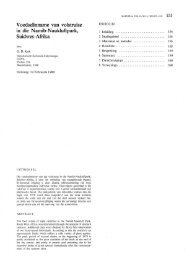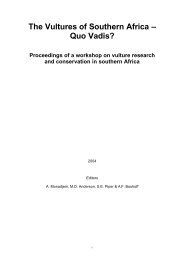Demarcation of Water Basins on National Level - EIS
Demarcation of Water Basins on National Level - EIS
Demarcation of Water Basins on National Level - EIS
You also want an ePaper? Increase the reach of your titles
YUMPU automatically turns print PDFs into web optimized ePapers that Google loves.
Basin <str<strong>on</strong>g>Demarcati<strong>on</strong></str<strong>on</strong>g><br />
The basin comprises the surface catchments <str<strong>on</strong>g>of</str<strong>on</strong>g> the omiramba Otjoz<strong>on</strong>dju, Eiseb and Epukiro. They all<br />
originate in Steinhausen-Hochfeld area and flow in an eastern directi<strong>on</strong> through the Omaheke semidesert<br />
into Botswana. The flow <str<strong>on</strong>g>of</str<strong>on</strong>g> the groundwater is also directed from all sides towards the Eiseb<br />
‘Graben’ area and from there further towards Botswana. The discharge area is downstream the<br />
Okavango Delta where the groundwater most probably evaporates in saltpans <str<strong>on</strong>g>of</str<strong>on</strong>g> the central Kalahari.<br />
The Rietf<strong>on</strong>tein and Chapmans rivers, draining the Rietf<strong>on</strong>tein Block area and the quartzitic outcrop<br />
area east <str<strong>on</strong>g>of</str<strong>on</strong>g> Gobabis are also included into the basin.<br />
2.13.2. <str<strong>on</strong>g>Water</str<strong>on</strong>g> Supply and C<strong>on</strong>sumpti<strong>on</strong><br />
Gobabis, the capital <str<strong>on</strong>g>of</str<strong>on</strong>g> the Omaheke Regi<strong>on</strong> is partly supplied from a well field located northeast <str<strong>on</strong>g>of</str<strong>on</strong>g><br />
Gobabis, within Nosib Group quartzite. Groundwater flow is directed towards the east into the basin<br />
centre. Gobabis, although being located in the Black Nossob catchment area is proposed to be also<br />
included into the Eiseb-Epukiro Basin, and the basin boundary runs through Gobabis Town.<br />
2.13.3. Populati<strong>on</strong> Density and Political/Administrative Areas<br />
The populati<strong>on</strong> density is intermediate at the basin margins, where the groundwater sources are<br />
sufficient in terms quantity and quality. Towards the basin centre the groundwater potential is very<br />
low and there are large areas with no people or very low numbers <str<strong>on</strong>g>of</str<strong>on</strong>g> people. The main towns or<br />
settlements such as Gobabis, Epukiro, Summerdown, Otjinene and Gam are all located in the basin<br />
margin areas. For political and administrative aspects it is c<strong>on</strong>sidered necessary to combine the Eiseb<br />
and Epukiro basins as well as the minor above menti<strong>on</strong>ed catchments into <strong>on</strong>e basin and to have<br />
Gobabis included as the place where most <str<strong>on</strong>g>of</str<strong>on</strong>g> the decisi<strong>on</strong> makers and administrators are located.<br />
2.13.4. Infrastructure, Socio-Ec<strong>on</strong>omic and Cultural Units<br />
The Trans Kalahari Highway leads through the basin, linking the business centres in South Africa with<br />
Walvis Bay Harbour. A link to the Caprivi Highway in the north is planned, which would link the<br />
Trans Kalahari Highway with the Grootf<strong>on</strong>tein-Tsumkwe road and open up large areas <str<strong>on</strong>g>of</str<strong>on</strong>g> the basin<br />
centre for future development.<br />
The basin is mainly populated by Otjiherero speaking people, and <strong>on</strong>ly in the north, parts <str<strong>on</strong>g>of</str<strong>on</strong>g> the former<br />
Bushmanland with predominantly San speaking people are included.<br />
2.13.5. Other<br />
Since the middle 1990s Otjiherero speaking people from Botswana return to Namibian soil for resettlement<br />
<strong>on</strong> invitati<strong>on</strong> by the Namibian Government. The water supply situati<strong>on</strong> is, however,<br />
problematic and a number <str<strong>on</strong>g>of</str<strong>on</strong>g> attempts to develop sufficient groundwater resources were unsuccessful.<br />
Only recently some success was reported by a team <str<strong>on</strong>g>of</str<strong>on</strong>g> hydrogeologist working under the technical cooperati<strong>on</strong><br />
project between Namibia and Germany. New groundwater sources were found in the Eiseb<br />
Graben area, which could be utilised to supply the local populati<strong>on</strong> and the settlers. The explorati<strong>on</strong><br />
work has to c<strong>on</strong>tinue for a better assessment <str<strong>on</strong>g>of</str<strong>on</strong>g> the aquifer potential. The aquifer seems to extend into<br />
neighbouring Botswana and a co-operati<strong>on</strong> with the foreign authorities is recommended.<br />
2.14 KAVANGO-OMATAKO BASIN<br />
2.14.1. Physiographic Parameters<br />
Bittner <str<strong>on</strong>g>Water</str<strong>on</strong>g> C<strong>on</strong>sult 2004 GTZ, MAWRD<br />
14




